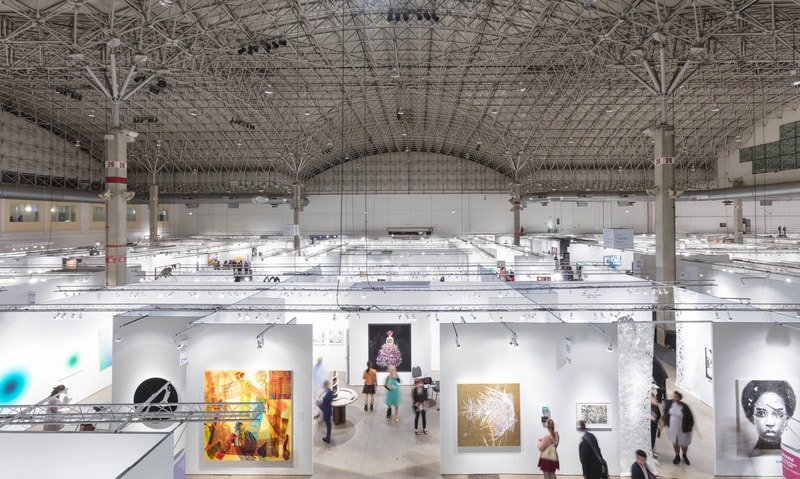Bringing together more than 170 galleries from 36 countries, Expo Chicago hosted its VIP preview on Thursday morning. The fair’s aisles were moderately filled during the first few hours, with a mass of people filling up the Navy Pier during the evening vernissage hours.
Now celebrating its tenth anniversary this year, Expo Chicago made apparent in this edition that it is still intent on bringing world-class art and leading curators to the Windy City for a fair experience unlike any other. The fair made good on its promise.
Below, is a look at the best on offer during the 2023 edition of Expo Chicago, which runs until Sunday, April 16.
Some of the works brought to the fair by the Cape Town–based gallery WHATIFTHEWORLD appeared to be unfinished. In fact, however, these pieces constituted discrete works themselves.
Artist Athi Patra-Ruga’s stunning portraits of his queer Black femme community, both contemporary members and members from generations prior, are made via a semi-obsessive process. He starts in pencil, then works in pastel, then tapestry, and finally stained glass, with the portraits evolving along the way. One of his subjects is Senegalese dancer Féral Benga, who moved to Paris in 1925, became a star at the Folies Bergère (at times performing in drag), befriended Josephine Baker, and posed for Carl Van Vechten and George Platt Lynes. Unlike these figures, Benga has faded into obscurity. Patra-Ruga’s works are meant to combat that near erasure, “a testament to the people who get forgotten,” the artist said during the VIP preview. By depicting Benga in drag at a time when right-wing conservative politicians in the US are legislating against it, “it’s highly political, but it’s highly necessary that I do that.”
In another drawing, the artist has posed musician Desire Marea as the late photographer Rotimi Fani-Kayode, who died of AIDS-related complications at 34 in 1989. By mixing these two temporalities, Patra-Ruga is also trying to create a new form of documentation for his community. Because there are many stereotypical portraits of Black men in the history of portraiture, Patra-Ruga sees his works as a form of “healing wherein I’m wresting them” from those prior depictions.
Toronto-based artist Oluseye is also focused on how objects construct memory. For his ongoing series titled “Eminado,” which means “good luck charm” in Yoruba, the artist has created a series of talismans using found objects (always in black, except for cowrie shells in some works) that he has collected while tracing the path of the transatlantic slave trade, moving from Africa to South America, the Caribbean, and the United States. (He photographs each object in situ so he has the location data in his personal archive.)
These small-scale sculptures can contain objects—combs, strands of acrylic hair, plugs, car parts, and more—from anywhere between two and six countries. Sometimes, these objects are brought together for aesthetic reasons. Other times, it’s because they share a history. In piecing them together, Oluseye said he is trying to “reimagine the talismans that Africans would have carried across the Atlantic” just a few centuries ago. In doing so, he hopes to “build a complex presentation of Blackness” and reconnect people.
Artist Athi Patra-Ruga’s stunning portraits of his queer Black femme community, both contemporary members and members from generations prior, are made via a semi-obsessive process. He starts in pencil, then works in pastel, then tapestry, and finally stained glass, with the portraits evolving along the way. One of his subjects is Senegalese dancer Féral Benga, who moved to Paris in 1925, became a star at the Folies Bergère (at times performing in drag), befriended Josephine Baker, and posed for Carl Van Vechten and George Platt Lynes. Unlike these figures, Benga has faded into obscurity. Patra-Ruga’s works are meant to combat that near erasure, “a testament to the people who get forgotten,” the artist said during the VIP preview. By depicting Benga in drag at a time when right-wing conservative politicians in the US are legislating against it, “it’s highly political, but it’s highly necessary that I do that.”
In another drawing, the artist has posed musician Desire Marea as the late photographer Rotimi Fani-Kayode, who died of AIDS-related complications at 34 in 1989. By mixing these two temporalities, Patra-Ruga is also trying to create a new form of documentation for his community. Because there are many stereotypical portraits of Black men in the history of portraiture, Patra-Ruga sees his works as a form of “healing wherein I’m wresting them” from those prior depictions.
Toronto-based artist Oluseye is also focused on how objects construct memory. For his ongoing series titled “Eminado,” which means “good luck charm” in Yoruba, the artist has created a series of talismans using found objects (always in black, except for cowrie shells in some works) that he has collected while tracing the path of the transatlantic slave trade, moving from Africa to South America, the Caribbean, and the United States. (He photographs each object in situ so he has the location data in his personal archive.)
These small-scale sculptures can contain objects—combs, strands of acrylic hair, plugs, car parts, and more—from anywhere between two and six countries. Sometimes, these objects are brought together for aesthetic reasons. Other times, it’s because they share a history. In piecing them together, Oluseye said he is trying to “reimagine the talismans that Africans would have carried across the Atlantic” just a few centuries ago. In doing so, he hopes to “build a complex presentation of Blackness” and reconnect people.
It’s increasingly rare that artists will make works specifically for an art fair, so it was a pleasant surprise to see this new sculpture, titled Hotel Palenque-Chicagos Worlds Fair, by New York–based artist Claudia Peña Salinas. The work responds to the 1933 World’s Fair, held in Chicago to celebrate the city’s centennial, which presented a reconstruction of a Mayan temple, and to Robert Smithson’s visit in 1969 to the Hotel Palenque in the southern Mexican state of Chiapas.
In a text about the work, Peña Salinas described the latter site as “a hotel in constant construction and destruction,” with Smithson going as far as to call it a “never-ending ruin” in a slide presentation from the year of his visit. Peña Salinas’s minimalist sculpture, consisting of a gold-plated armature, is meant to imitate the architecture of the hotel.
In one section, an original postcard showing a photograph of the Mayan temple from the World’s Fair that Peña Salinas was able to source. That fair is often credited with introducing the American public to Mayan architecture, with the widely disseminated postcards acting as a pre–social media information-sharing tool. To this postcard, Peña Salinas has added a short message to Smithson from the architect Frank Lloyd Wright, who visited the 1933 event, that she produced by plugging in their texts to an AI chatbot and prompting it to create a text. “I wonder what you make of this place if you were here with me,” the imagined Wright, who died in 1959, writes. The piece cleverly collapses the two time periods and brings them into the present.



Comment here